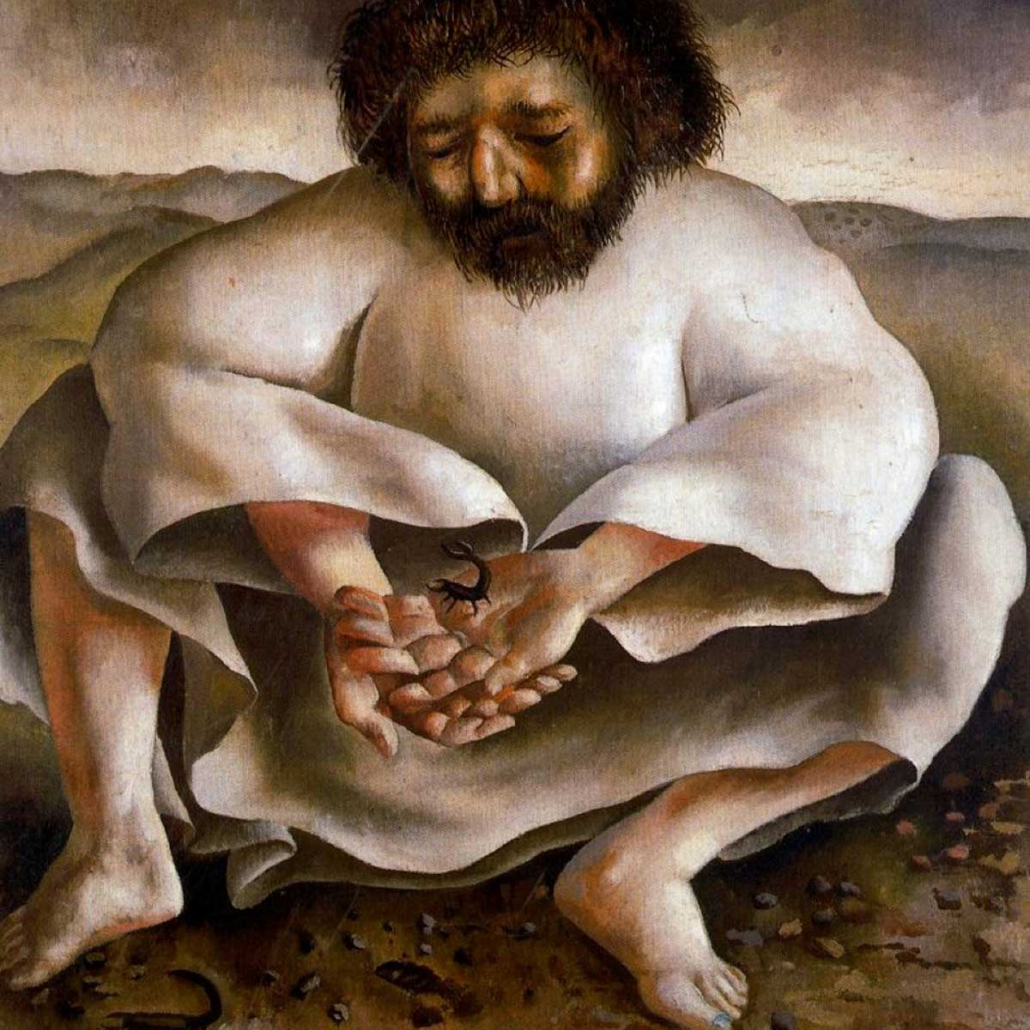Stanley Spencer, ‘The Scorpion’ (1939).
Visio Divina – ‘Scorpion’
The origin of the season of Lent lies not in a conscious re-enactment of Jesus’ time in the wilderness but in the preparation of Christians for the celebration of the resurrection of Christ at Easter.
British artist Stanley Spencer (1891-1959) sought to give some form to the 40 days of Lent.
In the 1930s-40s, Spencer set out to create 40 paintings, one for each day Christ was in the wilderness. However, the series Christ in the Wilderness was never completed; 18 drawings were made, and eight paintings were finished. They are currently held by the Art Gallery of WA.
Each artwork explores the solitary figure of Christ interacting with various elements of the wilderness – a hen, a scorpion, lilies and eagles.
Spencer served in Macedonia during World War I. The wilderness landscape likely draws on the rough terrain of that area. It is interesting to note that he started this series of artworks around the time of a personal wilderness. Spencer had lost his marriage and had left the family home because of a relationship with another woman. Unfortunately, this second relationship failed, and the world was on the cusp of the outbreak of World War II.
The figure of Jesus we see in these images is not the slim body commonly seen in many paintings but a bulky figure with billowing garments. Spencer envisioned the pictures hanging as a group on the ceiling of a church. In such a position, Jesus’ garments would be perceived as billowing, ethereal clouds.
Focus reading
Luke 11:9-13.
Trust
Looking at the image, we were drawn to Jesus’ hand holding the scorpion. He is holding and looking gently at something that most of us would be scared by or have a negative experience about. Yet, it is a demonstration of trust and care.
Sting
Some of us experienced revulsion toward this creature – but Jesus’ reaction is one of possible kindness, some thought even sadness. We noticed that his hand is swollen – is that from the scorpion sting – a reference to the crucifixion?
The scorpion
We all get stung or maimed by life. We may learn to hold and live with that agony or injury. The injury will not disappear, but we can be like Jesus in this image and contemplate our injury. How do we consider the other? Is the scorpion just doing scorpion things?
Contemplation
We contemplated our giftedness – our gifts to offer, gifts to receive … and how we are sometimes hurt. How to see goodness in the moment? And how do we hold goodness in our hands, even when others cannot see it? Sometimes we need to be wise and stand back. And how do we love when our wilderness state is self-imposed?
We were led to share the following prayers
“Help me to sit and listen.”
“In your darkest moments, you are not alone.”
“We share in darkness and light.”
“Love one another, even when love isn’t returned.”
“Darkness will not cover all the earth.”
“God’s work is love, and we need to be open to it.”
Next meditation will be April 10, 12pm. All welcome in the church and online:
Meeting ID: 828 4637 5215
Password: 895602.
The following guidelines (from https://www.prayerandpossibilities.com/pray-with-eyes-of-the-heart-visio-divina/) can be adapted for different occasions.
Find an image for prayer
You can use any type of image for Visio Divina. You might use images found in your church – a religious painting, a stained-glass window, or an icon.
Prepare your heart for prayer
Before you begin, choose your image and have it visible – either be near it in person or have the image pulled up on your phone or computer.
You may want to begin your time in prayer with a scripture reading. If you’re using a religious image, use the scripture related to that image. Or, use a Scripture from the day’s lectionary reading or just a favourite you want to pray.
Allow the image to speak to your heart
Open your eyes and look at the image you’ve selected. Let your eyes pause and focus on the part of the image they’re first drawn to.
Gaze upon just that part of the image for a minute or two. Then close your eyes, still seeing that part of the image in your mind.
Reflect on the entire image
Open your eyes and now look upon the whole image. Gaze upon all of the image, allowing it to draw forth a word, an emotion, or an image in your heart.
What do you hear God whispering into your heart? What thoughts or questions are raised? What emotions do you feel?
Continue to gaze and reflect as long as you need to, then briefly close and rest your eyes.
Pray through the image
Open your eyes. While looking upon the image, respond to God. Pray through the words, images, emotions, questions and thoughts that are now on your heart.
Continue to look upon the image as you pray. Then, close and rest your eyes briefly.
Rest and reflect in God
As you close out your time in prayer, open your eyes and gaze again upon the image. Rest in God’s presence as you reflect upon this prayer experience.
Consider how you’ll take this into your life. You may choose to journal about your experience.




